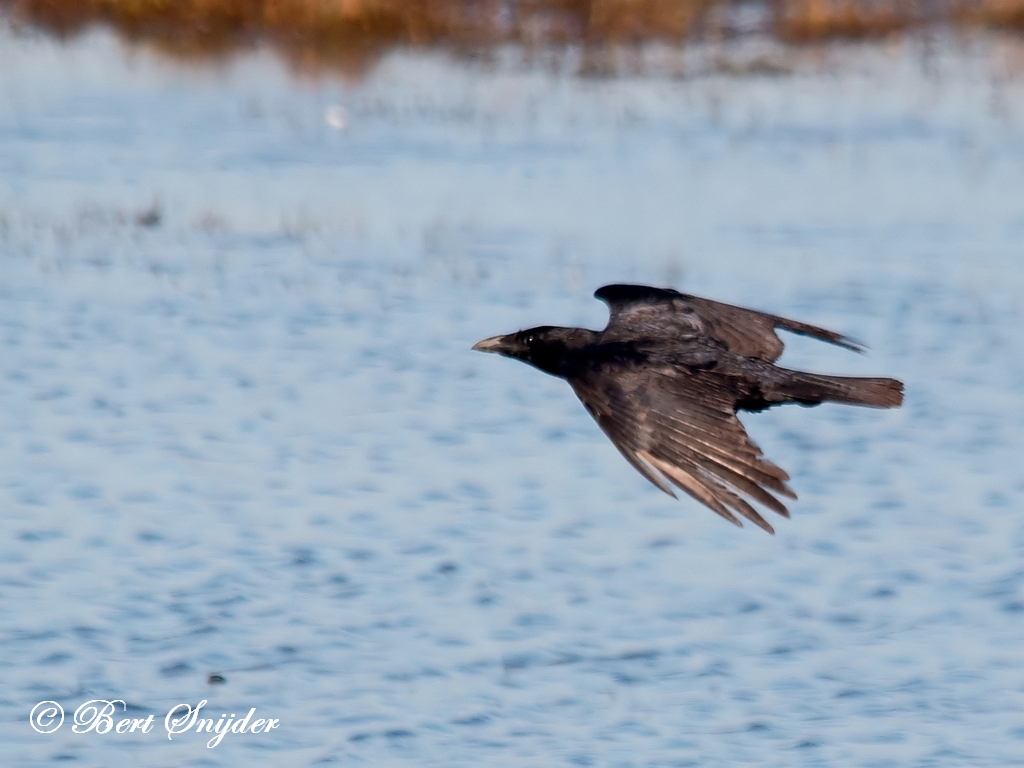Carrion Crow, Zwarte Kraai, Rabenkrähe, Gralha-preta, Corneja Negra
Spotted on our property Monte Horizonte in the Alentejo region of Portugal. Carrion Crow sound
The Carrion Crow (Corvus corone) is a member of the passerine order of birds and the crow family which is native to western Europe and eastern Asia.
The Carrion Crow was one of the many species originally described by Linnaeus in his 18th century work Systema Naturae and it still bears its original name of Corvus corone. The binomial name is derived from the Latin Corvus, “Raven” or “Crow”.

The Carrion Crow (Corvus corone) is a member of the passerine order of birds and the crow family which is native to western Europe and eastern Asia.
The Carrion Crow was one of the many species originally described by Linnaeus in his 18th century work Systema Naturae and it still bears its original name of Corvus corone. The binomial name is derived from the Latin Corvus, “Raven”, and Greek corone/??????, “crow”.
As well as the subspecies of the Hooded Crow being split off as a separate species, there is some discussion whether the eastern race of the Carrion Crow, orientalis is distinct enough to warrant specific status; the two taxa are well separated, and it has been proposed they could have evolved independently in the wetter, maritime regions at the opposite ends of the Eurasian landmass.
The plumage of Carrion Crow is black with a green or purple sheen, much greener than the gloss of the Rook. The bill, legs and feet are also black. It can be distinguished from the Common Raven by its size (48–52 cm or 18 to 21 inches in length) and from the Hooded Crow by its black plumage, but there is frequent confusion between it and the Rook. The beak of the Crow is stouter and in consequence looks shorter, and whereas in the adult Rook the nostrils are bare, those of the Crow are covered at all ages with bristle-like feathers.
This species breeds in western and central Europe, with an allied form or race C. c. orientalis (50–56 cm or 19 to 22 inches in length) occurring in eastern Asia. The separation of these two populations is now believed to have taken place during the last ice age, with the closely allied Hooded Crow (now given species status) filling the gap between. Fertile hybrids occur along the boundary between these two forms indicating their close genetic relationship. This is an example of the parapatric speciation model described by Ernst Mayr. The range of this hybrid of these two species appears to be moving to the northwest.
The Rook is generally gregarious and the Crow solitary, but Rooks occasionally nest in isolated trees, and Crows may feed with Rooks; moreover, Crows are often sociable in winter roosts. The most distinctive feature is the voice. The rook has a high-pitched kaaa, but the Crow’s guttural, slightly vibrant, deeper croaked kraa is distinct from any note of the rook.
The Carrion Crow is noisy, perching on the top of a tree and calling three or four times in quick succession, with a slight pause between each series of croaks. The wing-beats are slower, more deliberate than those of the Rook.
Though an eater of carrion of all kinds, the Carrion Crow will eat insects, worms, grain, small mammals, and scraps and will also steal eggs. Crows are scavengers by nature, which is why they tend to frequent sites inhabited by humans in order to feed on their household waste. Crows will also harass birds of prey or even foxes for their kills. Crows actively hunt and occasionally co-operate with other crows to make kills.
The bulky stick nest is usually placed in a tall tree, but cliff ledges, old buildings and pylons may be used as well. Nests are also occasionally placed on or near the ground. The nest resembles that of the Common Raven, but is less bulky. The four to six brown-speckled blue or greenish eggs are incubated for 17–19 days by the female alone, who is fed by the male. The young fledge after 32–36 days.
It is not uncommon for an offspring from the previous years to stay around and help rear the new hatchlings. Instead of seeking out a mate, it looks for food and assists the parents in feeding the young.
Other synonyms:
Asturian: Cuerva
Breton: Ar vran boutin, bran louet
Catalan: cornella, Cornella negra
Catalan (Balears): Cornella
Welsh: brân, Brân dyddyn, Brân fawr, Bran syddyn, Brân syddyn, Fawr bran, Milfran
Danish: Krage, Sortkrage
German: Aaskrahe, Aaskrähe, Krähe, Nebelkrähe, Nebel-krähe, Rabenkraehe, Rabenkrähe
English: Carrion Crow, Crow, Eurasian Crow, Hooded crow, West European Carrion Crow
Esperanto: korniko
Spanish: Corneja, Corneja Cenicienta, Corneja Común, Corneja negra, Graja
Estonian: vares
Basque: Belabeltza, bele, Cornella
Finnish: Nokivaris, Varis
Faroese: kráka
French: corneille, Corneille corbine, Corneille noire
Friulian: çore, cornile, corvat piçul
Frisian: krie, Swarte Krie
Irish: caróg, Caróg Dhubh, caróg dubh, Caróg Liath/Caróg Dhubh, corvo viaraz
Gaelic: Feannag, Fionnag, Starag
Galician: Cornella , Corvo pequeno
Manx: fannag
Croatian: Crna vrana, vrana
Hungarian: Dolmányos varjú, Kormos varjú, Kormos varjú/Dolmányos varjú, varjú
Icelandic: kráka
Italian: cornacchia, Cornacchia comune europea, Cornacchia nera, Cornaccia
Japanese: Hashi-boso garasu, Hashibosogarasu, Hashiboso-garasu
Cornish: bran, Kygvran
Latin: Corone corone, Corvus corone, Corvus corone corone
Ladino: agacion
Lithuanian: Juodoji varna, Kovas, varna
Dutch: kraai, Zwarte kraai
Norwegian: kråke, Russekråke, Svartkråke
Occitan: gralha
Polish: Czarna wrona, czarnowron, wrona
Portuguese: gralha cinzenta, gralha preta, Gralha-cinzenta, Gralha-preta
Romansh: corv nair, corv nair grisch
Romany: korung
Sardinian: arroga de monte, carroga, corbanca, corra, corrancra, corròncia, croanca, giacu, Gorrancra
Scots: Feannag, starrag
Northern Sami: Vuorazas, vuoražas, vuor??is
Albanian: sorra
Swedish: Kråka, Svartkråka
Sorbian, Lower: garona, karwona
Sorbian, Upper: wróna
Travel Birdwatching Holiday Alentejo, Vacation Portugal for birders to see birds on your trip.